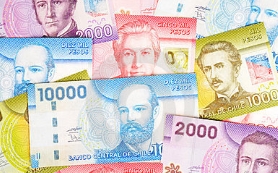The Chilean Peso’s Impact on the Forex Market

| Broker | Bonus | More |
|---|
History Behind the Chilean Peso
The area covered by the country of Chile today has been inhabited for about 14,000 years, with the original ethnic group being the Mapuche, who lived in the mountainous regions around the country’s Central Valley. Before the Spanish colonised the country during the 16th century, the Mapuches were hunter-gatherers who traded textiles, livestock, metals and ceramics with the Incas. However, after the Spanish arrived in 1540, trade in silver started up, and mining for gold and copper in the region began. The silver that was found in the mid-15th century was then used to produce silver coins. Mints were established in Peru, and the silver Spanish 8 Real coinage was commonly circulated in the Americas, becoming known as the Peso.
The first Spanish mint in Chile was established in 1749, in which half-ounce gold coins were produced. Chile won its independence from the Spanish in 1818 and from then on, the country began to produce the Chilean Peso which was valued to be equivalent to 8 Spanish Reals. Trade became complicated following the Declaration of Independence in the neighbouring regions, as they were still controlled by the Spanish, so Chile sought to expand its trade to the United States, France and England, with success in the trade of copper, grain, potassium nitrate and silver.
Chile’s first banknotes were issued around 1840, and from the mid-1850s, the Chilean Peso was pegged to the French Franc’s value. The gold standard was adopted in 1885, and Chile began to peg its currency to the British Pound. When the Panama Canal opened in 1914 and the First World War broke out, the economy of Chile began to weaken, so in 1925 the currency was reformed, with a central bank being established. The 1950s saw hyperinflation, which led to Chile replacing the Peso with the Escudo. This remained as legal tender for over 10 years. However it, too, suffered from high inflation, so the Peso was once more restored in 1975, at which time the Peso was floated against other international currencies in a crawling-band system. The Peso was pegged to the USD in 1982, but the crawling-band system was put in place again 2 years later. Chile’s central bank was given full autonomy in 1990, with the Chilean Peso being floated freely again in 1999.
Chile’s Monetary Policy
The Central Bank of Chile is responsible for implementing the country’s monetary policies, with the five-member board of directors meeting every month. Since 1999, an inflation-targeting policy framework has been followed by the Chilean Central Bank, the aim of which is to achieve inflation targets for the year of 3% with a 1%-point tolerance margin to either side. Decisions over interest rates are published on the same day as the monetary policy meeting is held, with the full minutes of the meeting being published 11 days later. These minutes explain the analysis of all policy options and how each member voted. Monetary policy reports are also published by the bank every quarter, which discuss the board’s opinion on recent and short-term, medium-term and long-term trends regarding inflation, and how that will affect monetary policy decisions.
The Chilean Economy
Chile ranks 44th in the world in terms of its GDP, and has a market-based economy which is recognised for its sound economic policies, healthy banks and strong foreign trade links. These factors combine to give the country one of the strongest ratings in sovereign bonds in the whole of South America. The country has adopted a policy of counter-cyclical budgets to accumulate over US$20 billion in surplus sovereign wealth funds, held outside the country, which can be used for financing fiscal stimuli in times of economic downturn. Chile’s top industries include lithium, copper, fish processing, foodstuffs, steel, iron, wood products, textiles, cement and transportation equipment. The Chilean economy is quite dependent upon its exports, which represent about a third of the country’s GDP. Around 75% of total exports are made up of commodities, and copper alone accounts for about 19% of these. Despite a slowdown during 1999, Chile’s real growth has continued to be around 4% per year over the last decade. Chile is committed to trade liberalisation, and holds trading agreements with more than 60 countries and regions such as the EU, the USA, Mexico, South Korea, India and China.


